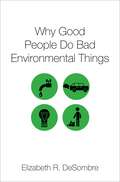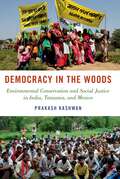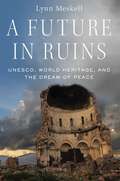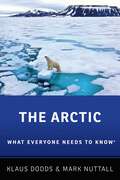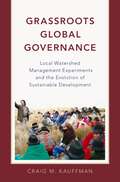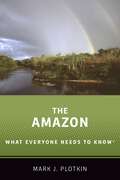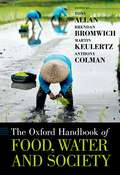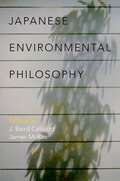- Table View
- List View
AT RISK TRL C: How and Why We are Harmed by Toxic Chemicals (The Romanell Lectures)
by Carl F. CranorThe world is awash in chemicals created by fellow citizens, but we know little to nothing about them. Understanding whether even the most prevalent ones are toxic would take decades. Many people have tragically suffered serious diseases and premature death, including children during development. Why has this occurred? Many factors contribute, but two important ones are the laws permitting this and the manner in which science has been used to identify and assess whether or not products are toxic. Both are the outcome of legislative, corporate, and judicial choices. Congress created laws that in fact keep public health officials and the wider population in the dark about the toxicity of virtually all substances other than prescription drugs and pesticides. Facing considerable ignorance about toxic substances, impartially motivated scientists seeking to protect the public health are constrained by the natural pace of studies to reveal toxic effects. Corporate pressures on public health officials and scientific obstruction substantially heighten the barriers to protecting the public. When people have suffered serious as well as life-threatening diseases likely traceable to toxic substances, judicial errors barring relevant science in the personal injury (tort) law can and have frustrated redress of injustices. Under both public health law and the tort law, there are possibilities for improved approaches, provided public leaders make different and better choices. This book describes these issues and suggests how we could be better protected from myriad toxic substances in our midst.
Why Good People Do Bad Environmental Things
by Elizabeth R. DeSombreNo one sets out to intentionally cause environmental problems. All things being equal, we are happy to protect environmental resources; in fact, we tend to prefer our air cleaner and our species protected. But despite not wanting to create environmental problems, we all do so regularly in the course of living our everyday lives. Why do we behave in ways that cause environmental harm? It is often easy and inexpensive to behave in ways with bad environmental consequences, but more difficult and costly to take environmentally friendly actions. The incentives we face, some created by the nature of environmental resources, some by social and political structures, often do not make environmentally beneficial behavior the most likely choice. Furthermore, our behavior is conditioned by habits and social norms that fail to take environmental protection into consideration. In this book, Elizabeth R. DeSombre integrates research from political science, sociology, psychology, and economics to understand why bad environmental behavior makes perfect sense. As she notes, there is little evidence that having more information about environmental problems or the way an individual's actions contribute to them changes behavior in meaningful ways, and lack of information is rarely the underlying cause that connects behavior to harm. In some cases such knowledge may even backfire, as people come to see themselves as powerless to address huge global problems and respond by pushing these issues out of their minds. The fact that causing environmental problems is never anyone's primary goal means that people are happy to stop causing them if the alternative behavior still accomplishes their underlying goals. If we can figure out why those problems are caused, when no one intends to cause them, we can develop strategies that work to shift behavior in a positive direction. Over the course of this book, DeSombre considers the role of structure, incentives, information, habit, and norms on behavior in order to formulate lessons about how these factors lead to environmentally problematic behavior, and what understanding their effects can tell us about ways to change behavior. To prevent or address environmental problems, we have to understand why even good people do bad environmental things.
WHY GOOD PEOPLE DO BAD ENVIRON THINGS C
by Elizabeth R. DeSombreNo one sets out to intentionally cause environmental problems. All things being equal, we are happy to protect environmental resources; in fact, we tend to prefer our air cleaner and our species protected. But despite not wanting to create environmental problems, we all do so regularly in the course of living our everyday lives. Why do we behave in ways that cause environmental harm? It is often easy and inexpensive to behave in ways with bad environmental consequences, but more difficult and costly to take environmentally friendly actions. The incentives we face, some created by the nature of environmental resources, some by social and political structures, often do not make environmentally beneficial behavior the most likely choice. Furthermore, our behavior is conditioned by habits and social norms that fail to take environmental protection into consideration. In this book, Elizabeth R. DeSombre integrates research from political science, sociology, psychology, and economics to understand why bad environmental behavior makes perfect sense. As she notes, there is little evidence that having more information about environmental problems or the way an individual's actions contribute to them changes behavior in meaningful ways, and lack of information is rarely the underlying cause that connects behavior to harm. In some cases such knowledge may even backfire, as people come to see themselves as powerless to address huge global problems and respond by pushing these issues out of their minds. The fact that causing environmental problems is never anyone's primary goal means that people are happy to stop causing them if the alternative behavior still accomplishes their underlying goals. If we can figure out why those problems are caused, when no one intends to cause them, we can develop strategies that work to shift behavior in a positive direction. Over the course of this book, DeSombre considers the role of structure, incentives, information, habit, and norms on behavior in order to formulate lessons about how these factors lead to environmentally problematic behavior, and what understanding their effects can tell us about ways to change behavior. To prevent or address environmental problems, we have to understand why even good people do bad environmental things.
Democracy in the Woods: Environmental Conservation and Social Justice in India, Tanzania, and Mexico (Studies Comparative Energy and Environ)
by Prakash KashwanHow do societies negotiate the apparently competing agendas of environmental protection and social justice? Why do some countries perform much better than others on this front? Democracy in the Woods addresses these question by examining land rights conflicts-and the fate of forest-dependent peasants-in the context of the different forest property regimes in India, Tanzania, and Mexico. These three countries are prominent in the scholarship and policy debates about national forest policies and land conflicts associated with international support for nature conservation. This unique comparative study of national forestland regimes challenges the received wisdom that redistributive policies necessarily undermine the goals of environmental protection. It shows instead that the form that national environmental protection efforts take - either inclusive (as in Mexico) or exclusive (as in Tanzania and, for the most part, in India) - depends on whether dominant political parties are compelled to create structures of political intermediation that channel peasant demands for forest and land rights into the policy process. This book offers three different tests of this theory of political origins of forestland regimes. First, it explains why it took the Indian political elites nearly sixty years to introduce meaningful reforms of the colonial-era forestland regimes. Second, it successfully explains the rather counterintuitive local outcomes of the programs for formalization of land rights in India, Tanzania, and Mexico. Third, it provides a coherent explanation of why each of these three countries proposes a significantly different distribution of the benefits of forest-based climate change mitigation programs being developed under the auspices of the United Nations. In its political analysis of the control over and the use of nature, this book opens up new avenues for reflecting on how legacies of the past and international interventions interject into domestic political processes to produce specific configurations of environmental protection and social justice. Democracy in the Woods offers a theoretically rigorous argument about why and in what specific ways politics determine the prospects of a socially just and environmentally secure world. *Included in the Studies in Comparative Energy and Environmental Politics Series
Democracy in the Woods: Environmental Conservation and Social Justice in India, Tanzania, and Mexico (Studies Comparative Energy and Environ)
by Prakash KashwanHow do societies negotiate the apparently competing agendas of environmental protection and social justice? Why do some countries perform much better than others on this front? Democracy in the Woods addresses these question by examining land rights conflicts-and the fate of forest-dependent peasants-in the context of the different forest property regimes in India, Tanzania, and Mexico. These three countries are prominent in the scholarship and policy debates about national forest policies and land conflicts associated with international support for nature conservation. This unique comparative study of national forestland regimes challenges the received wisdom that redistributive policies necessarily undermine the goals of environmental protection. It shows instead that the form that national environmental protection efforts take - either inclusive (as in Mexico) or exclusive (as in Tanzania and, for the most part, in India) - depends on whether dominant political parties are compelled to create structures of political intermediation that channel peasant demands for forest and land rights into the policy process. This book offers three different tests of this theory of political origins of forestland regimes. First, it explains why it took the Indian political elites nearly sixty years to introduce meaningful reforms of the colonial-era forestland regimes. Second, it successfully explains the rather counterintuitive local outcomes of the programs for formalization of land rights in India, Tanzania, and Mexico. Third, it provides a coherent explanation of why each of these three countries proposes a significantly different distribution of the benefits of forest-based climate change mitigation programs being developed under the auspices of the United Nations. In its political analysis of the control over and the use of nature, this book opens up new avenues for reflecting on how legacies of the past and international interventions interject into domestic political processes to produce specific configurations of environmental protection and social justice. Democracy in the Woods offers a theoretically rigorous argument about why and in what specific ways politics determine the prospects of a socially just and environmentally secure world. *Included in the Studies in Comparative Energy and Environmental Politics Series
Spirits of Place in American Literary Culture
by John GattaWhat might it mean, existentially and spiritually, for humans to form an intimate relation with particular sites or dwelling places on earth? In ancient Rome, the notion of a locale's genius loci signaled recognition of its enchanted, enspirited identity. But in a digitalized America of unprecedented mobility can place still matter as seed ground for the soul? Such questions have been broached by ecocritics concerned with how place-inflected experience figures in literature, and by theologians concerned with ecotheology and ecospirituality. This book offers a uniquely integrative perspective, informed by a theological phenomenology of place that takes fuller account of the spiritualities associated with built environments than ecocriticism typically does. Spirits of Place blends theological and cultural analysis with personal reflection, while focusing on the multi-layered witness presented by American literature. John Gatta's interpretive readings range across texts by an array of canonical as well as lesser-known writers. Along the way, it addresses such themes as the religious implications of localism vs. globalism; the diverse spiritualities associated with long-term residency, resettlement, and pilgrimage; why some sites seem more hallowed than others; and how the creative spirit of Imagination figures in place-identified perceptions of the numinous. Whether in Christian or other religious terms, no discrete place matters absolutely. Yet this study demonstrates how and why hallowed geography and the sacramentality of place have mattered throughout our cultural history.
Spirits of Place in American Literary Culture
by John GattaWhat might it mean, existentially and spiritually, for humans to form an intimate relation with particular sites or dwelling places on earth? In ancient Rome, the notion of a locale's genius loci signaled recognition of its enchanted, enspirited identity. But in a digitalized America of unprecedented mobility can place still matter as seed ground for the soul? Such questions have been broached by ecocritics concerned with how place-inflected experience figures in literature, and by theologians concerned with ecotheology and ecospirituality. This book offers a uniquely integrative perspective, informed by a theological phenomenology of place that takes fuller account of the spiritualities associated with built environments than ecocriticism typically does. Spirits of Place blends theological and cultural analysis with personal reflection, while focusing on the multi-layered witness presented by American literature. John Gatta's interpretive readings range across texts by an array of canonical as well as lesser-known writers. Along the way, it addresses such themes as the religious implications of localism vs. globalism; the diverse spiritualities associated with long-term residency, resettlement, and pilgrimage; why some sites seem more hallowed than others; and how the creative spirit of Imagination figures in place-identified perceptions of the numinous. Whether in Christian or other religious terms, no discrete place matters absolutely. Yet this study demonstrates how and why hallowed geography and the sacramentality of place have mattered throughout our cultural history.
A Future in Ruins: UNESCO, World Heritage, and the Dream of Peace
by Lynn MeskellBest known for its World Heritage program committed to "the identification, protection and preservation of cultural and natural heritage around the world considered to be of outstanding value to humanity," the United Nations Educational, Scientific and Cultural Organization (UNESCO) was founded in 1945 as an intergovernmental agency aimed at fostering peace, humanitarianism, and intercultural understanding. Its mission was inspired by leading European intellectuals such as Henri Bergson, Marie Curie, Albert Einstein, Thomas Mann, H. G. Wells, and Aldous and Julian Huxley. Often critiqued for its inherent Eurocentrism, UNESCO and its World Heritage program today remain embedded within modernist principles of "progress" and "development" and subscribe to the liberal principles of diplomacy and mutual tolerance. However, its mission to prevent conflict, destruction, and intolerance, while noble and much needed, increasingly falls short, as recent battles over the World Heritage sites of Preah Vihear, Chersonesos, Jerusalem, Palmyra, Aleppo, and Sana'a, among others, have underlined. A Future in Ruins is the story of UNESCO's efforts to save the world's heritage and, in doing so, forge an international community dedicated to peaceful co-existence and conservation. It traces how archaeology and internationalism were united in Western initiatives after the political upheavals of the First and Second World Wars. This formed the backdrop for the emergent hopes of a better world that were to captivate the "minds of men." UNESCO's leaders were also confronted with challenges and conflicts about their own mission. Would the organization aspire to intellectual pursuits that contributed to the dream of peace or instead be relegated to an advisory and technical agency? An eye-opening and long overdue account of a celebrated yet poorly understood agency, A Future in Ruins calls on us all to understand how and why the past comes to matter in the present, who shapes it, and who wins or loses as a consequence.
FUTURE IN RUINS C: UNESCO, World Heritage, and the Dream of Peace
by Lynn MeskellBest known for its World Heritage program committed to "the identification, protection and preservation of cultural and natural heritage around the world considered to be of outstanding value to humanity," the United Nations Educational, Scientific and Cultural Organization (UNESCO) was founded in 1945 as an intergovernmental agency aimed at fostering peace, humanitarianism, and intercultural understanding. Its mission was inspired by leading European intellectuals such as Henri Bergson, Marie Curie, Albert Einstein, Thomas Mann, H. G. Wells, and Aldous and Julian Huxley. Often critiqued for its inherent Eurocentrism, UNESCO and its World Heritage program today remain embedded within modernist principles of "progress" and "development" and subscribe to the liberal principles of diplomacy and mutual tolerance. However, its mission to prevent conflict, destruction, and intolerance, while noble and much needed, increasingly falls short, as recent battles over the World Heritage sites of Preah Vihear, Chersonesos, Jerusalem, Palmyra, Aleppo, and Sana'a, among others, have underlined. A Future in Ruins is the story of UNESCO's efforts to save the world's heritage and, in doing so, forge an international community dedicated to peaceful co-existence and conservation. It traces how archaeology and internationalism were united in Western initiatives after the political upheavals of the First and Second World Wars. This formed the backdrop for the emergent hopes of a better world that were to captivate the "minds of men." UNESCO's leaders were also confronted with challenges and conflicts about their own mission. Would the organization aspire to intellectual pursuits that contributed to the dream of peace or instead be relegated to an advisory and technical agency? An eye-opening and long overdue account of a celebrated yet poorly understood agency, A Future in Ruins calls on us all to understand how and why the past comes to matter in the present, who shapes it, and who wins or loses as a consequence.
The Arctic: What Everyone Needs to Know® (What Everyone Needs To Know®)
by Klaus Dodds Mark NuttallConversations defining the Arctic region often provoke debate and controversy -- for scientists, this lies in the imprecise and imaginary line known as the Arctic Circle; for countries like Canada, Russia, the United States, and Denmark, such discussions are based in competition for land and resources; for indigenous communities, those discussions are also rooted in issues of rights. These shifting lines are only made murkier by the threat of global climate change. In the Arctic Ocean, the consequences of Earth's warming trend are most immediately observable in the multi-year and perennial ice that has begun to melt, which threatens ice-dependent microorganisms and, eventually, will disrupt all of Arctic life and raise sea levels globally. In The Arctic: What Everyone Needs to Know®, Klaus Dodds and Mark Nuttall offer concise answers to the myriad questions that arise when looking at the circumpolar North. They focus on its peoples, politics, environment, resource development, and conservation to provide critical information about how changes there can, and will, affect our entire globe and all of its inhabitants. Dodds and Nuttall explore how the Arctic's importance has grown over time, the region's role during the Cold War, indigenous communities and their history, and the past and future of the Arctic's governance, among other crucial topics.
ARCTIC WENK C: What Everyone Needs to Know® (What Everyone Needs To Know®)
by Klaus Dodds Mark NuttallConversations defining the Arctic region often provoke debate and controversy -- for scientists, this lies in the imprecise and imaginary line known as the Arctic Circle; for countries like Canada, Russia, the United States, and Denmark, such discussions are based in competition for land and resources; for indigenous communities, those discussions are also rooted in issues of rights. These shifting lines are only made murkier by the threat of global climate change. In the Arctic Ocean, the consequences of Earth's warming trend are most immediately observable in the multi-year and perennial ice that has begun to melt, which threatens ice-dependent microorganisms and, eventually, will disrupt all of Arctic life and raise sea levels globally. In The Arctic: What Everyone Needs to Know®, Klaus Dodds and Mark Nuttall offer concise answers to the myriad questions that arise when looking at the circumpolar North. They focus on its peoples, politics, environment, resource development, and conservation to provide critical information about how changes there can, and will, affect our entire globe and all of its inhabitants. Dodds and Nuttall explore how the Arctic's importance has grown over time, the region's role during the Cold War, indigenous communities and their history, and the past and future of the Arctic's governance, among other crucial topics.
Grassroots Global Governance: Local Watershed Management Experiments and the Evolution of Sustainable Development
by Craig M. KauffmanWhen international agreements fail to solve global problems like climate change, transnational networks attempt to address them by implementing "global ideas" -- policies and best practices negotiated at the global level-locally around the world. Grassroots Global Governance not only explains why some efforts succeed and others fail, but also why the process of implementing global ideas locally causes these ideas to evolve. Drawing on nodal governance theory, the book shows how transnational actors' success in putting global ideas into practice depends on the framing and network capacity-building strategies they use to activate networks of grassroots actors influential in local social and policy arenas. Grassroots actors neither accept nor reject global ideas as presented by outsiders. Instead, they negotiate whether and how to adapt them to fit local conditions. This contestation produces experimentation, and results in unique institutional applications of global ideas infused with local norms and practices. Grassroots actors ultimately guide this process due to their unique ability to provide the pressure needed to push the process forward. Experiments that endure are perceived as "successful," empowering those actors involved to activate transnational networks to scale up and diffuse innovative local governance models globally. These models carry local norms and practices to the international level where they challenge existing global approaches and stimulate new global governance institutions. By guiding the way global ideas evolve through local experimentation, grassroots actors reshape international actors' thinking, discourse, organizing, and the strategies they pursue globally. This makes them grassroots global governors. To demonstrate this, the book compares transnational efforts to implement local Integrated Watershed Management programs across Ecuador and shows how local experiments altered the global debate regarding sustainable development and stimulated a new global movement dedicated to changing the way sustainable development is practiced. In doing so, the book reveals the grassroots level as not merely the object of global governance, but rather a terrain where global governance is constructed.
The Amazon: What Everyone Needs to Know® (What Everyone Needs to Know)
by Mark J. PlotkinThe Amazon is a land of superlatives. The complex ecosystem covers an area about the size of the continental U.S. The Amazon River discharges 57 million gallons of water per second--in two hours, this would be enough to supply all of New York City's 7.5 million residents with water for a year. Its flora and fauna are abundant. Approximately one of every four flowering plant species on earth resides in the Amazon. A single Amazonian river may contain more fish species than all the rivers in Europe combined. It is home to the world's largest anteater, armadillo, freshwater turtle, and spider, as well as the largest rodent (which weighs over 200 lbs.), catfish (250 lbs.), and alligator (more than half a ton). The rainforest, which contains approximately 390 billion trees, plays a vital role in stabilizing the global climate by absorbing massive amounts of carbon dioxide--or releasing it into the atmosphere if the trees are destroyed. Severe droughts in both Brazil and Southeast Asia have been linked to Amazonian deforestation, as have changing rainfall patterns in the U.S., Europe, and China. The Amazon also serves as home to millions of people. Approximately seventy tribes of isolated and uncontacted people are concentrated in the western Amazon, completely dependent on the land and river. These isolated groups have been described as the most marginalized peoples in the western hemisphere, with no voice in the decisions made about their futures and the fate of their forests. In this addition to the What Everyone Needs to Know® series, ecologist and conservation expert, Mark J. Plotkin, who has spent 40 years studying Amazonia, its peoples, flora, and fauna. The Amazon offers an engaging overview of this irreplaceable ecosystem and the challenges it faces.
AMAZON WENK C: What Everyone Needs to Know® (What Everyone Needs to Know)
by Mark J. PlotkinThe Amazon is a land of superlatives. The complex ecosystem covers an area about the size of the continental U.S. The Amazon River discharges 57 million gallons of water per second--in two hours, this would be enough to supply all of New York City's 7.5 million residents with water for a year. Its flora and fauna are abundant. Approximately one of every four flowering plant species on earth resides in the Amazon. A single Amazonian river may contain more fish species than all the rivers in Europe combined. It is home to the world's largest anteater, armadillo, freshwater turtle, and spider, as well as the largest rodent (which weighs over 200 lbs.), catfish (250 lbs.), and alligator (more than half a ton). The rainforest, which contains approximately 390 billion trees, plays a vital role in stabilizing the global climate by absorbing massive amounts of carbon dioxide--or releasing it into the atmosphere if the trees are destroyed. Severe droughts in both Brazil and Southeast Asia have been linked to Amazonian deforestation, as have changing rainfall patterns in the U.S., Europe, and China. The Amazon also serves as home to millions of people. Approximately seventy tribes of isolated and uncontacted people are concentrated in the western Amazon, completely dependent on the land and river. These isolated groups have been described as the most marginalized peoples in the western hemisphere, with no voice in the decisions made about their futures and the fate of their forests. In this addition to the What Everyone Needs to Know® series, ecologist and conservation expert, Mark J. Plotkin, who has spent 40 years studying Amazonia, its peoples, flora, and fauna. The Amazon offers an engaging overview of this irreplaceable ecosystem and the challenges it faces.
The Oxford Handbook of Food, Water and Society (Oxford Handbooks)
by Tony Allan, Brendan Bromwich, Martin Keulertz, Anthony ColmanFood, water and society: what is managed by whom, and with what impacts? Our food supply chains are at risk. Water resources--sometimes scarce, often damaged, and always under-valued--are among the major reasons why food and water security rank high every year in the World Economic Forum's major global risk analysis. A stable and sustainable food system is critical to society's survival. This Handbook shows that keeping the food system stable comes at the expense of the environment, especially of water resources and those who consume and manage them. The way the food system operates reflects hard political realities. Rather than pay for the environmental costs of sustainable production, society expects food at ever lower prices. Governments reflect their electorates in this regard. Given that farm production may account for as little as 10% of the food value chain in wealthy economies, it is striking that governments have been unwilling (or unable) to put in place the essential laws and accountability that would enable famers to ensure both production and stewardship. Corporate food traders, food manufacturers, and retailers on the other hand operate in markets that make profits and pay taxes. But these corporations are not contractually bound to utilize highly nutritious, sustainably produced food commodities. The articles in this Oxford Handbook have been written by water and food system scientists and professionals, including farmers, rarely heard voices who understand the problems of food producers, food manufacturers, and regulating markets and public policy. The articles address the blind spots of society and its public policymakers, demonstrating the importance of informing society about the consequences of its food preferences and the heroic challenges it is beginning to face. The damage we are doing to our water and soil ecosystems is as important as the damage we do to the atmosphere. Impressed by the technical and organizational advances of the past two centuries, the contributors featured in this book also take note of where economic inefficiencies and cultural deadlock in a 4,000 year old system are putting our critical food supply chains at risk.
China and the Geopolitics of Rare Earths
by Sophia KalantzakosFeaturing a new foreword that brings the book up to date Rare earths are elements that are found in the Earth's crust, and are vital ingredients for the production of a wide variety of high tech, defense, and green technologies-everything from iPhones and medical technologies to wind turbines, efficiency lighting, smart bombs, and submarines. While they are not particularly "rare" in availability, they are difficult and expensive to mine. Yet, China has managed to gain control over an estimated 97 percent of the rare earth industry since the 1990s through cheap production, high export taxes, and artificial limitations of supply. Rare earths, and China's monopoly over them, became international news after China "unofficially" curtailed exports to Japan, the United States, and Europe in 2010. This embargo followed a collision between Chinese and Japanese boats in the East China Sea, a locus of geopolitical and economic tension between the two countries. Although the World Trade Organization forced China to scrap its restrictions, it still holds a stranglehold over these elements that are so critical to the economic and security interests of the United States and its allies. In this book, Sophia Kalantzakos argues that the 2010 rare earth crisis signaled more than just a trade dispute. Rather, it raises questions about China's use of economic statecraft, and must be regarded as a part of the larger discourse of global power relations. Importantly, she also argues that the failure of political actors in major industrial nations to enact comprehensive and effective policy solutions, or the scientific and business communities to devise sustainable rare earth production outside of China, points to future resource competition. Featuring a new foreword, the paperback edition of China and the Geopolitics of Rare Earths examines the impacts of growing worldwide resource competition and the complexities policymakers face as they develop strategies and responses in an increasingly globalized world.
CHINA & THE GEOPOLITICS OF RARE EARTHS C
by Sophia KalantzakosFeaturing a new foreword that brings the book up to date Rare earths are elements that are found in the Earth's crust, and are vital ingredients for the production of a wide variety of high tech, defense, and green technologies-everything from iPhones and medical technologies to wind turbines, efficiency lighting, smart bombs, and submarines. While they are not particularly "rare" in availability, they are difficult and expensive to mine. Yet, China has managed to gain control over an estimated 97 percent of the rare earth industry since the 1990s through cheap production, high export taxes, and artificial limitations of supply. Rare earths, and China's monopoly over them, became international news after China "unofficially" curtailed exports to Japan, the United States, and Europe in 2010. This embargo followed a collision between Chinese and Japanese boats in the East China Sea, a locus of geopolitical and economic tension between the two countries. Although the World Trade Organization forced China to scrap its restrictions, it still holds a stranglehold over these elements that are so critical to the economic and security interests of the United States and its allies. In this book, Sophia Kalantzakos argues that the 2010 rare earth crisis signaled more than just a trade dispute. Rather, it raises questions about China's use of economic statecraft, and must be regarded as a part of the larger discourse of global power relations. Importantly, she also argues that the failure of political actors in major industrial nations to enact comprehensive and effective policy solutions, or the scientific and business communities to devise sustainable rare earth production outside of China, points to future resource competition. Featuring a new foreword, the paperback edition of China and the Geopolitics of Rare Earths examines the impacts of growing worldwide resource competition and the complexities policymakers face as they develop strategies and responses in an increasingly globalized world.
Strange and Wonderful: Exotic Flora and Fauna in Image and Imagination
by Karen Polinger FosterEver since the creation of the world's first botanical and zoological gardens five thousand years ago, people have collected, displayed, and depicted plants and animals from lands beyond their everyday experience. Some did so to demonstrate power over distant territories, others to enhance prestige by possessing something no one had seen before. Exotica also satisfied intellectual curiosity, furthered scientific research, and educated and entertained. In addition, exotica, especially their state-sponsored representation, were often instruments of political persuasion, and in turn exerted considerable influence over expansionist policies. More than an account of gardens and menageries from antiquity to the present, Strange and Wonderful explores the imagery of exotic flora and fauna in Western art, seeking answers to certain fundamental and universal questions. How do artists, schooled in traditional modes of rendering the familiar, deal with the new and strange? Why are rare species deliberately introduced into images otherwise devoid of the unusual? What is the pictorialized relationship between exotic reality and artistic imagination? Karen Polinger Foster takes readers on a journey across millennia and around the globe, telling fascinating stories and meeting along the way such characters as Hatshepsut's baboons, Charlemagne's elephant, Dürer's rhinoceros, and Victoria's hippopotamus. What emerges is a sense of just how strong and far-reaching the pull of the unknown and exotic has been across time and space. Ultimately, images of the wonderful reveal as much about the indigenous as they do about the strange, enabling us to glimpse more vividly the power of imagination to mold the unknown to its purposes. This dazzling and richly illustrated volume offers a thoughtful, much-needed inquiry into a very human phenomenon.
Strange and Wonderful: Exotic Flora and Fauna in Image and Imagination
by Karen Polinger FosterEver since the creation of the world's first botanical and zoological gardens five thousand years ago, people have collected, displayed, and depicted plants and animals from lands beyond their everyday experience. Some did so to demonstrate power over distant territories, others to enhance prestige by possessing something no one had seen before. Exotica also satisfied intellectual curiosity, furthered scientific research, and educated and entertained. In addition, exotica, especially their state-sponsored representation, were often instruments of political persuasion, and in turn exerted considerable influence over expansionist policies. More than an account of gardens and menageries from antiquity to the present, Strange and Wonderful explores the imagery of exotic flora and fauna in Western art, seeking answers to certain fundamental and universal questions. How do artists, schooled in traditional modes of rendering the familiar, deal with the new and strange? Why are rare species deliberately introduced into images otherwise devoid of the unusual? What is the pictorialized relationship between exotic reality and artistic imagination? Karen Polinger Foster takes readers on a journey across millennia and around the globe, telling fascinating stories and meeting along the way such characters as Hatshepsut's baboons, Charlemagne's elephant, Dürer's rhinoceros, and Victoria's hippopotamus. What emerges is a sense of just how strong and far-reaching the pull of the unknown and exotic has been across time and space. Ultimately, images of the wonderful reveal as much about the indigenous as they do about the strange, enabling us to glimpse more vividly the power of imagination to mold the unknown to its purposes. This dazzling and richly illustrated volume offers a thoughtful, much-needed inquiry into a very human phenomenon.
JAPANESE ENVIRONMENTAL PHILOSOPHY C
by J. Baird Callicott and James McRaeJapanese Environmental Philosophy is an anthology that responds to the environmental problems of the 21st century by drawing from Japanese philosophical traditions to investigate our relationships with other humans, nonhuman animals, and the environment. It contains chapters from fifteen top scholars from Japan, the United States, and Europe. The essays cover a broad range of Japanese thought, including Zen Buddhism, Shintoism, the Kyoto School, Japanese art and aesthetics, and traditional Japanese culture.
West Germany and the Iron Curtain: Environment, Economy, and Culture in the Borderlands
by Astrid M. EckertWest Germany and the Iron Curtain takes a fresh look at the history of Cold War Germany and the German reunification process from the spatial perspective of the West German borderlands that emerged along the volatile inter-German border after 1945. These border regions constituted the Federal Republic's most sensitive geographical space where it had to confront partition and engage its socialist neighbor East Germany in concrete ways. Each issue that arose in these borderlands - from economic deficiencies, border tourism, environmental pollution, landscape change, and the siting decision for a major nuclear facility - was magnified and mediated by the presence of what became the most militarized border of its day, the Iron Curtain. In topical chapters, the book addresses the economic consequences of the border for West Germany, which defined the border regions as depressed areas, and examines the cultural practice of western tourism to the Iron Curtain. At the heart of this deeply-researched book stands an environmental history of the Iron Curtain that explores transboundary pollution, landscape change, and a planned nuclear industrial site at Gorleben that was meant to bring jobs into the depressed border regions. The book traces these subjects across the caesura of 1989/90, thereby integrating the "long" postwar era with the post-unification decades. As Eckert demonstrates, the borderlands that emerged with partition and disappeared with reunification did not merely mirror some larger developments in the Federal Republic's history but actually helped to shape them.
WEST GERMANY & THE IRON CURTAIN C: Environment, Economy, and Culture in the Borderlands
by Astrid M. EckertWest Germany and the Iron Curtain takes a fresh look at the history of Cold War Germany and the German reunification process from the spatial perspective of the West German borderlands that emerged along the volatile inter-German border after 1945. These border regions constituted the Federal Republic's most sensitive geographical space where it had to confront partition and engage its socialist neighbor East Germany in concrete ways. Each issue that arose in these borderlands - from economic deficiencies, border tourism, environmental pollution, landscape change, and the siting decision for a major nuclear facility - was magnified and mediated by the presence of what became the most militarized border of its day, the Iron Curtain. In topical chapters, the book addresses the economic consequences of the border for West Germany, which defined the border regions as depressed areas, and examines the cultural practice of western tourism to the Iron Curtain. At the heart of this deeply-researched book stands an environmental history of the Iron Curtain that explores transboundary pollution, landscape change, and a planned nuclear industrial site at Gorleben that was meant to bring jobs into the depressed border regions. The book traces these subjects across the caesura of 1989/90, thereby integrating the "long" postwar era with the post-unification decades. As Eckert demonstrates, the borderlands that emerged with partition and disappeared with reunification did not merely mirror some larger developments in the Federal Republic's history but actually helped to shape them.
Stemming the Tide: Human Rights and Water Policy in a Neoliberal World
by Madeline BaerWhen privatization of public services swept the developing world in the 1990s, it was part of a seemingly unstoppable tide of neoliberal reforms aimed at reducing the role of the state and reorienting economies toward market-led policymaking. Water privatization, one of the more unpopular policies of the neoliberal development paradigm, sparked a particularly fierce debate and gave rise to a movement of self-proclaimed "water warriors" who advocated for legal recognition of water as a basic human right to be protected and fulfilled by states. Broadening the debate, Madeline Baer questions whether either approach -- the market approach or a human rights-based approach -- leads to improved access to water. More specifically, Baer explores how the human right to water and sanitation is fulfilled in different contexts, whether neoliberal policies like privatization pose a threat to the right to water, and whether rights fulfillment leads to meaningful social change. Using two case studies -- Chile, the most extreme case of water privatization in the developing world, and Bolivia, the birthplace of the global movement for the human right to water -- Stemming the Tide uncovers the conditions under which the right to water and sanitation can be fulfilled, as well as the obstacles to fulfilment. Ultimately this book argues that deepening mechanisms for citizen participation, strengthening accountability, and creating alternatives to the state/market binary can help achieve meaningful social transformation in the water sector.
Stemming the Tide: Human Rights and Water Policy in a Neoliberal World
by Madeline BaerWhen privatization of public services swept the developing world in the 1990s, it was part of a seemingly unstoppable tide of neoliberal reforms aimed at reducing the role of the state and reorienting economies toward market-led policymaking. Water privatization, one of the more unpopular policies of the neoliberal development paradigm, sparked a particularly fierce debate and gave rise to a movement of self-proclaimed "water warriors" who advocated for legal recognition of water as a basic human right to be protected and fulfilled by states. Broadening the debate, Madeline Baer questions whether either approach -- the market approach or a human rights-based approach -- leads to improved access to water. More specifically, Baer explores how the human right to water and sanitation is fulfilled in different contexts, whether neoliberal policies like privatization pose a threat to the right to water, and whether rights fulfillment leads to meaningful social change. Using two case studies -- Chile, the most extreme case of water privatization in the developing world, and Bolivia, the birthplace of the global movement for the human right to water -- Stemming the Tide uncovers the conditions under which the right to water and sanitation can be fulfilled, as well as the obstacles to fulfilment. Ultimately this book argues that deepening mechanisms for citizen participation, strengthening accountability, and creating alternatives to the state/market binary can help achieve meaningful social transformation in the water sector.
Greenovation: Urban Leadership on Climate Change
by Joan FitzgeraldCollectively, cities take up a relatively tiny amount of land on the earth, yet emit 72 percent of greenhouse gas emissions. Clearly, cities need to be at the center of any broad effort to reduce climate change. In Greenovation, the eminent urban policy scholar Joan Fitzgerald argues that too many cities are only implementing random acts of greenness that will do little to address the climate crisis. She instead calls for "greenovation"--using the city as a test bed for adopting and perfecting green technologies for more energy--efficient buildings, transportation, and infrastructure more broadly. Further, Fitzgerald contends that while many city mayors cite income inequality as a pressing problem, few cities are connecting climate action and social justice-another aspect of greenovation. Focusing on the biggest producers of greenhouse gases in cities, buildings, energy and transportation, Fitzgerald examines how greenovating cities are reducing emissions overall and lays out an agenda for fostering and implementing urban innovations that can help reverse the path toward irrevocable climate damage. Drawing on interviews with practitioners in more than 20 North American and European cities, she identifies the strategies and policies they are employing and how support from state, provincial and national governments has supported or thwarted their efforts. A uniquely urban-focused appraisal of the economic, political, and social debates that underpin the drive to "go green," Greenovation helps us understand what is arguably the toughest policy problem of our era: the increasing impact of anthropocentric climate change on modern social life.

